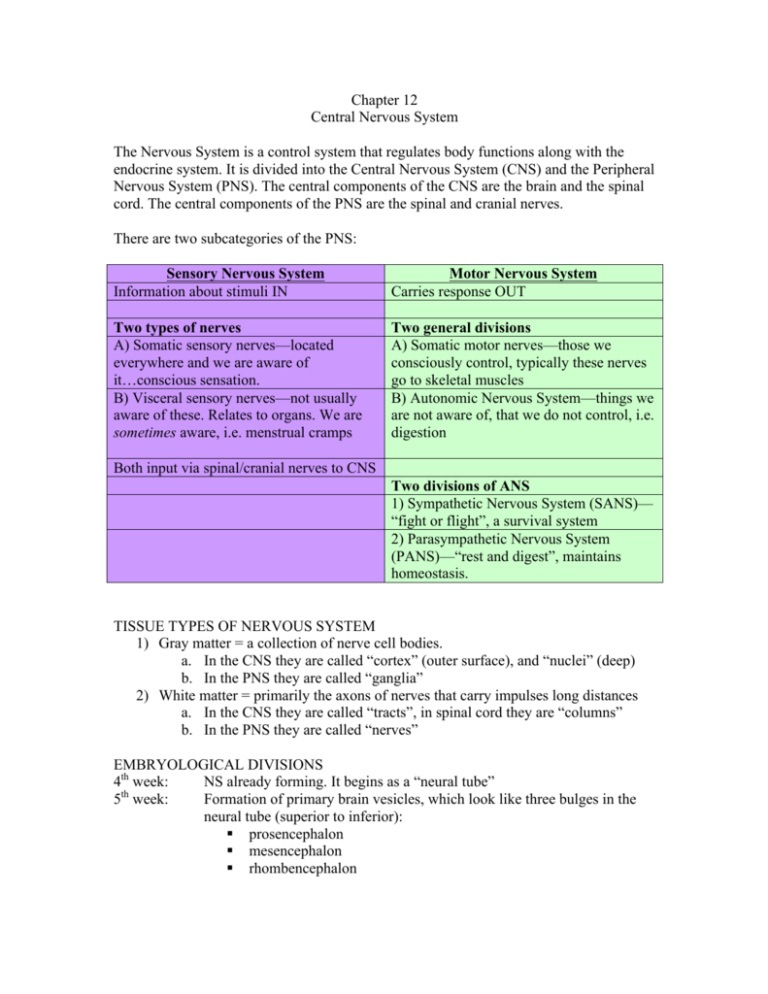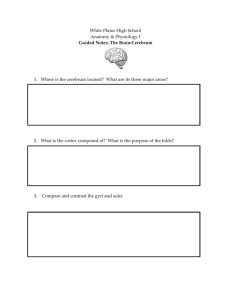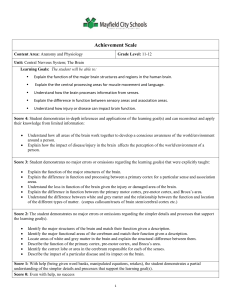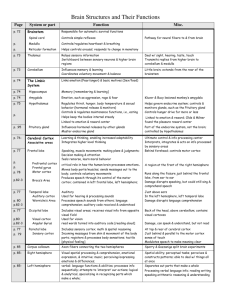A&P CNS - Straight A Nursing Student
advertisement

Chapter 12 Central Nervous System The Nervous System is a control system that regulates body functions along with the endocrine system. It is divided into the Central Nervous System (CNS) and the Peripheral Nervous System (PNS). The central components of the CNS are the brain and the spinal cord. The central components of the PNS are the spinal and cranial nerves. There are two subcategories of the PNS: Sensory Nervous System Information about stimuli IN Motor Nervous System Carries response OUT Two types of nerves A) Somatic sensory nerves—located everywhere and we are aware of it…conscious sensation. B) Visceral sensory nerves—not usually aware of these. Relates to organs. We are sometimes aware, i.e. menstrual cramps Two general divisions A) Somatic motor nerves—those we consciously control, typically these nerves go to skeletal muscles B) Autonomic Nervous System—things we are not aware of, that we do not control, i.e. digestion Both input via spinal/cranial nerves to CNS Two divisions of ANS 1) Sympathetic Nervous System (SANS)— “fight or flight”, a survival system 2) Parasympathetic Nervous System (PANS)—“rest and digest”, maintains homeostasis. TISSUE TYPES OF NERVOUS SYSTEM 1) Gray matter = a collection of nerve cell bodies. a. In the CNS they are called “cortex” (outer surface), and “nuclei” (deep) b. In the PNS they are called “ganglia” 2) White matter = primarily the axons of nerves that carry impulses long distances a. In the CNS they are called “tracts”, in spinal cord they are “columns” b. In the PNS they are called “nerves” EMBRYOLOGICAL DIVISIONS 4th week: NS already forming. It begins as a “neural tube” th 5 week: Formation of primary brain vesicles, which look like three bulges in the neural tube (superior to inferior): § prosencephalon § mesencephalon § rhombencephalon End 5th week: Bulges continue to differentiate and secondary vesicles are formed. o The prosencephalon forms into: telencephalon diencephalons o The mesencephalon no significant changes o Rhombencephalon develops into: metencephalon myelencephalon Throughout the remainder of development the cells/divisions continue to develop into the six divisions of the brain: o telencephalon will form cerebrum (1) o diencephalon will continue to be the diencephalon – there are three regions (2) o mesencephalon will also have the same name (located in the midbrain) (3) o metencephalon forms two parts of the adult brain: o anteriorly is the pons (4) o posteriorly is the cerebellum (little cerebrum) (5) o myelencephalon will form medulla oblongata (6) th 4 week th 5 week End of the 5th week Telencephalon 6 divisions of brain Cerebrum Diencephalon Diencephalon Mesencephalon Mesencephalon Metencephalon Pons (anteriorly) Cerebellum (posteriorly) Mylencephalon Medulla oblongata Prosencephalon Mesencephalon Neural tube Rhombencephalon VENTRICLES OF THE BRAIN Ventricles are fluid-filled spaces in the brain, that are CONTINUOUS with the central canal of the spinal cord. They develop from the central space of the neural tube. Anatomy of ventricles 1-4 Ventricles #1 & #2: -the lateral ventricles that have a ram’s horn shape Ventricle #3: -narrow, slit-like space at the midline Ventricle #4: -more open than #3, located posteriorly and inferiorly, near the cerebellum and medulla oblongata The ventricles are CONNECTED via: Interverticular foramen: -a “doorway” connecting each lateral ventricle to the third ventricle Cerebral aqueduct: -a “hallway” between the third and fourth ventricle -located in the mid-brain Medial and lateral apertures: -three openings that connect the fourth ventricle to the subarachnoid space surrounding the brain THE CEREBRUM The cerebrum has a wrinkled appearance due to its fissures, sulci and gyri (ridges). Fissures of the cerebrum are deep grooves, and since there are fewer of them they are named. The LOGITUDINAL FISSURE separates the two hemispheres. The TRANSVERSE CEREBRAL FISSURE separates the cerebrum above from the cerebellum below. Pretty easy to spot! Sulci are shallower grooves on the surface of the brain, but they’re not as random as you’d think. Some of them are in the same place on everyone, and these have names! The LATERAL SULCUS separates the frontal lobe above from the temporal lobes. The CENTRAL SULCUS is on the lateral side of the brain and is the only sulcus to run from the longitudinal fissure to the lateral sulcus. Sheep do not have this, but people do! The PARIETO-OCCIPITAL SULCUS is viewable when the brain is cut in half. It separates the parietal and occipital lobes along the medial surface. Sheep do not have this either…they’re dumb. Gyri are between fissures and sulci (they are rounded ridges on the surface of the brain). The two most important gyri are the PRECENTRAL GYRUS (anatomical name for the gyrus anterior to the central sulcus) and the POSTCENTRAL GYRUS (anatomical name for the gyrus posterior to the central sulcus). Functional name for precentral gyrus = Primary Motor Cortex Functional name for postcentral gyrus = Primary Somatosensory Cortex REGIONS OF THE CEREBRUM The cerebrum is divided into three general regions…the cortex, the internal white matter and the basal nuclei. The CORTEX is the superficial gray matter of the brain. It is unique to humans and apes…thinking comes from the cortex! Hmmmmm…. The internal WHITE MATTER are the tracts connecting the cortex to other areas of gray matter. The BASAL NUCLEI are deep gray matter. These regions surround the LATERAL VENTRICLES. In other words, the lateral ventricals are surrounded by the cerebrum. The CORTEX also has various LOBES! 5 of them, actually. 1. Frontal lobe is just beneath the frontal bone. a. It is closely associated with motor output (do, say, think) 2. Parietal lobe is deep to the parietal bones a. Somatosensory area (touch, cold, heat, vibration) 3. Occipital lobe is at the very back part of the brain a. Vision ONLY…a lot of area for just one sense! 4. Temporal lobe has more variety of functions a. Speech, hearing, memory 5. Insula is deep to the temporal area, visible when you pull apart the lateral sulcus. a. Taste, visceral sensation, equilibrium CEREBRUM GENERALIZATIONS The cerebrum has three types of cortical areas: motor, sensory and association. Each hemisphere is concerned with the activity on the opposite side of the body. The cerebrum utilizes LATERALIZATION, which means that it is structurally symmetric, but functionally asymmetric. Also, no one function is entirely localized to one region. MOTOR AREAS are the primary motor cortex, the premotor cortex, Broca’s area, and the frontal eye field. o The PRIMARY MOTOR CORTEX is the functional name for the PRECENTRAL GYRUS. It initiates conscious muscle movement. o The PREMOTOR CORTEX is anterior to the precentral gyrus. It modifies input from the primary motor cortex and involves the control of learned pattern movement, such as walking. It controls groups of muscles. o BROCA’S AREA is the speech center of the brain, and it is inferior to the premotor cortex. It is classically on the left side only. Though this area produces speech, it is active prior to speaking. It prepares thought and thinking about speaking. It is also active in planning other motor activity. o The FRONTAL EYE FIELD is superior to Broca’s area. It initiates voluntary eye movement. SENSORY AREAS are the primary somatosensory cortex, primary visual cortex, primary auditory cortex, olfactory cortex and the insular regions. o The PRIMARY SOMATOSENSORY CORTEX is in the postcentral gyrus. It receives input from skin, muscles, joints and tendons. It takes in raw, unprocessed information. o The PRIMARY VISUAL CORTEX is posterior tip and medial aspects of the occipital lobe. It is the largest cortical sensory area and it receives initial visual input (also raw, unprocessed data). o The PRIMARY AUDITORY CORTEX is superior to the margin of the temporal lobe. It receives initial input for pitch, volume, location (also raw data). o The OLFACTORY CORTEX is located at the medial temporal lobe. It receives the sense of smell and is part of the old rhinencephalon, the region now devoted to memory and emotion. This explains why smells will strongly trigger memories and emotions. o The INSULAR REGIONS are the GUSTATORY CORTEX (perceive taste), VISCERAL SENSORY AREA (detects sensations in organs), and VESTIBULAR CORTEX (input regarding balance). ASSOCIATION AREAS lie near the primary areas they relate to and include the somatosensory association area, visual association area, and auditory association area. o The SOMATOSENSORY ASSOCIATION AREA is posterior to the central gyrus. It integrates somatic sensory information. o The VISUAL ASSOCIATION AREA surrounds the primary visual cortex in the occipital lobe, and is the largest cortical sensory area. It integrates visual input for visual recognition. o The AUDITORY ASSOCIATION AREA is posterior to the primary area. It integrates auditory input for discrimination of sounds. MULTIMODAL ASSOCIATION AREAS are also called integrative centers. They take input from various association areas and put it all together. These include the prefrontal cortex and posterior association area. The PREFONTAL CORTEX is anterior to the frontal lobe. It is involved in what makes me ME…intellect, complex learning (cognition), recall, personality, abstract thought, reasoning, conscience and self-awareness. The POSTERIOR ASSOCIATION AREA (also called general interpretive area) is located at the inferior parietal, posterior temporal and occipital lobe. It integrates various sensory association areas together, providing awareness of surroundings (“gestalt”…the “big picture!”) LATERALIZATION Each hemisphere specializes in certain types of activities. The CATEGORICAL HEMISPHERE is used when we learn. It has control over our logical, rule-oriented tasks such as langugage skills, math, logical reasoning and rote memory. This is on the LEFT SIDE in 90% of people. The REPRESENTATIONAL HEMISPHERE excels in visual and spatial tasks as well as interpretive tasks. This includes spatial orientation, intuition, emotion, art and music. This is on the RIGHT SIDE in 90% of people. WHITE MATTER There are three types of white matter tracts: commisures, association fibers, and projection fibers. 1) Commissures connect to the opposite hemisphere…there are three important ones. a. Corpus collosum (this one is the most significant) b. Anterior commisure c. Posterior commisure 2) Assocation fibers connect different parts in the same hemisphere. 3) Projection fibers connect the cortex to lower brain centers. These are long, so the parts get named. a. Internal capsule = bundles of fibers that pass between thalamus and basal nuclei b. Coronal radiata = fanning of fibers toward the cortex BASAL NUCLEI Basal nuclei is the gray matter deep to white tracts. Function of basal nuclei: -Modulation/fine-tuning of motor output -Especially involved with initiation/cessation of slow or patterned movement such as walking -May also be involved with regulation of attention and cognition Anatomy of basal nuclei: -The CORPUS STRIATUM is made up of two parts: -CAUDATE NUCLEUS (comma shaped) -LENTIFORM NUCLEUS (has two parts) -PUTAMEN (lateral part of LN) -GLOBUS PALLIDUS (medial part of LN) -CLAUSTRUM -AMYGDALA is almond shaped and at the end of the tail on the caudate nucleus. The DIENCEPHALON surrounds the third ventricle and is made up of three parts: 1) Thalamus – forms the lateral walls of the third ventricle 2) Hypothalamus – forms the floor and anterior wall of the third ventricle 3) Epithalamus – forms the roof and posterior wall of the third ventricle The THALAMUS is made up of two (paired) ovoid regions that sit side by side. They are connected across the midline by the INTERTHALAMAC ADHESION (only in 80% of people). Functionally the thalamus is divided into about a dozen nuclei. Its function is to act as a relay station/switching terminal for sensory and motor impulses…it is the Grand Central Station of the brain! The HYPOTHALAMUS includes two mammillary bodies (olfactory relay nuclei). The hypothalamus has a variety of diverse functions: o autonomic control of visceral activities o mediates emotional response The pituitary gland o temperature regulation hangs below the o regulates hunger and thirst hypothalamus o regulates sleep/wake cycle o controls endocrine secretion The EPITHALAMUS also has two parts. o Pineal gland sits at the posterior part of the epithalamus. It is a small, pea-sized gland that secretes melatonin and regulates the sleep/wake cycle o Choroid plexus is the superior portion. It secretes cerebrospinal fluid. Marieb, E. N. (2006). Essentials of human anatomy & physiology (8th ed.). San Francisco: Pearson/Benjamin Cummings. Martini, F., & Ober, W. C. (2006). Fundamentals of anatomy & physiology (7th ed.). San Francisco, CA: Pearson Benjamin Cummings.









